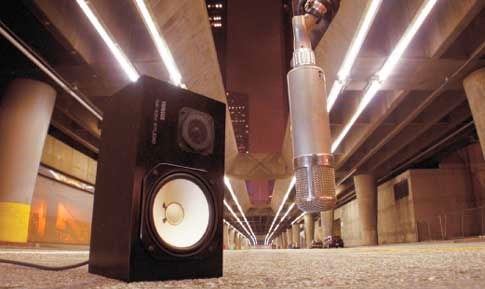
Some years ago, MPEG published a very interesting article of Charles Maynes talking about his approach on the use of the worldizing technique:
For some of us in sound and music circles, “worldizing” has long held a special sense of the exotic. Worldizing is the act of playing back a recording in a real-world environment, allowing the sound to react to that environment, and then re-recording it so that the properties of the environment become part of the newly recorded material. The concept is simple, but its execution can be remarkably complex.
In Walter Murch’s superb essay on the reconstruction of the Orson Welles film A Touch of Evil, he quotes from a 58-page memo that Welles wrote to Universal to lay out his vision for the movie. At one point, Welles describes how he wants to treat the music during a scene between Janet Leigh and Akim Tamiroff, and he offers as elegant a description of worldizing as I can think of:
The music itself should be skillfully played but it will not be enough, in doing the final sound mixing, to run this track through an echo chamber with a certain amount of filter. To get the effect we’re looking for, it is absolutely vital that this music be played back through a cheap horn in the alley outside the sound building. After this is recorded, it can then be loused up even further in the process of rerecording. But a tinny exterior horn is absolutely necessary, and since it does not represent very much in the way of money, I feel justified in insisting upon this, as the result will be really worth it.
At the time, Universal did not revise Touch of Evil according to these notes, but the movie’s recent reconstruction incorporates these ideas. Worldizing is now a technique that has been with us for some time and will likely be used and refined for years to come.
Great article! BTW, the articles mentions new products coming on the market in 2004 that do “convolution”. Audio convolution tools have been available since 1992 in the free SoundHack program by Tom Erbe.
http://www.soundhack.com/freeware.php
Cool, some of those examples are very interesting.
Im looking for some reasonably accurate portable speakers for worldizing at the moment, has anyone used the remote audio speakeasy ?
Or ideas for alternatives that dont need mains power?
@Haydn, I usually use a small, relatively flat EQ Fostex monitor. If I can get my car within 300 feet, I run power off of an inverter and use my laptop as the source. I have not yet been in the position that it was not possible.
I would also check the EQ of the speakers – you can make adjustments to your source audio to create a more true playback.
If you’re doing convolution reverb, get a measurement mic (or two). Traditional mics will have dips and won’t give you a true representation of the impulse.
On a related note… this reminded me of Ghost in the Shell 2, when they took a gigantic music box, recorded it in a ware house, and then took speakers into caves and recorded the sound of the original music box to give it a HUGE feel. The sound design that went into the movie was very impressive!
Hi Phil-
the convolution in Soundhack is not really as practical in the manner that many have gotten used to with things like Altiverb or TL Space. Yamaha also developed a hardware convolution reverb which was quite nice sounding. A lot has sort of changed since 2004, but not as much as would have thought….